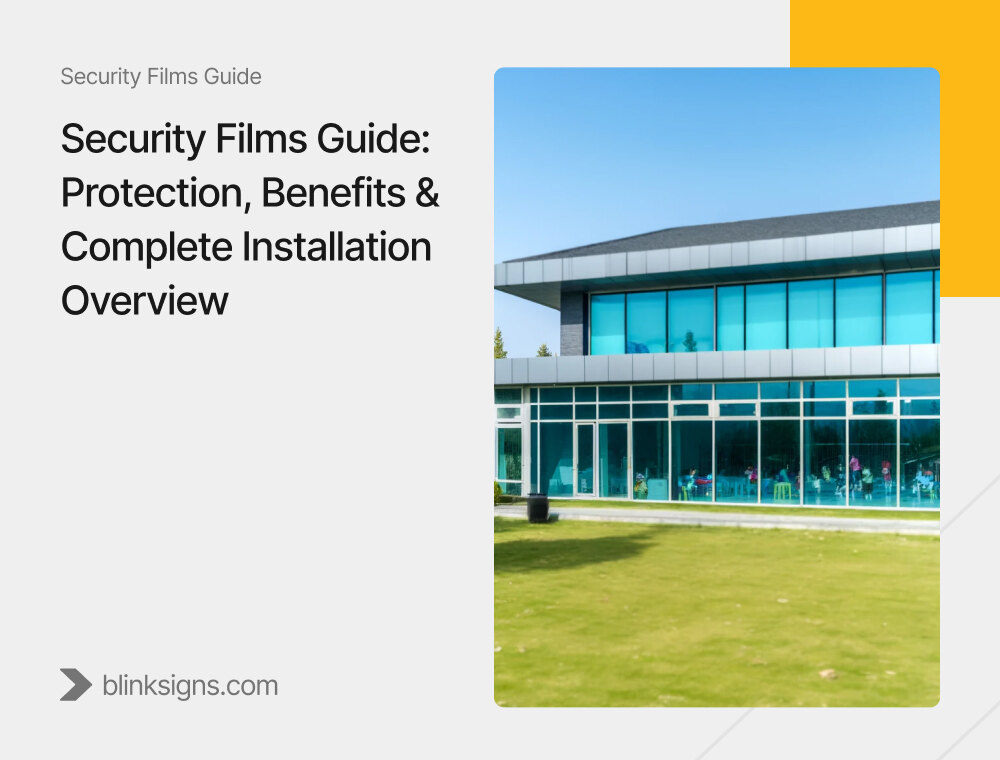
Security Films Guide: Protection, Benefits & Complete Installation Overview
The Glass Problem Businesses Cannot Ignore
A single sheet of glass often stands between your business and the outside world. It looks elegant but fragile, vulnerable, and costly when it fails. A smash-and-grab burglary can empty a retail display in minutes. A sudden storm can shatter storefront windows, putting employees and customers at risk. Even everyday sunlight can fade merchandise and increase energy bills.
This vulnerability is not only a bother for property managers, business owners, and school administrators; it is a liability. Insurance premiums climb, safety compliance questions arise, and the sense of security within a space diminishes. The reality is that traditional glass cannot meet today’s security demands independently.
This is where security window films step in. More than just a thin adhesive layer, these films are engineered to hold glass together under pressure, reduce forced entry attempts, and extend the life of your windows.
At BlinkSigns, we observe companies in various sectors, including retail, healthcare, educational institutions, and corporate headquarters, using security films as a workable way to protect, control costs, and have peace of mind.
What Are Security Films?
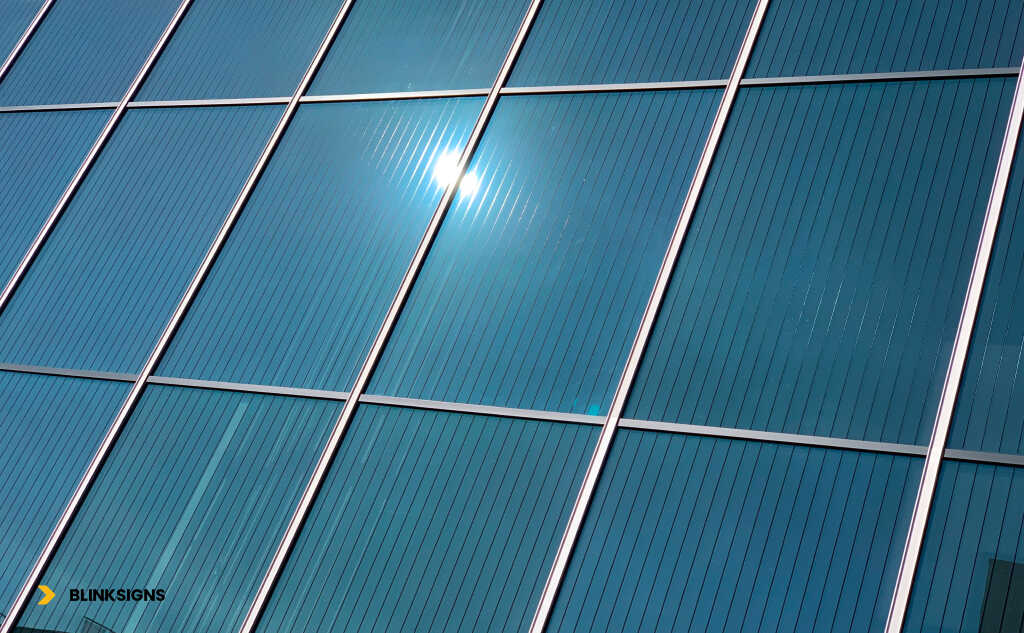
What Are Security Films
Security films are multi-layered polyester sheets that bond directly to glass surfaces using pressure-sensitive adhesives. Once applied, they transform ordinary glass into safety glazing that resists shattering during impact, intrusion attempts, or severe weather.
Unlike standard window tinting, which focuses on aesthetics and solar control, anti-shatter and blast mitigation films are designed with protection at their core. The thickness of these films, which range from 4 to 12 mil, allows them to resist anything from minor break-ins to powerful impact forces.
How Security Films Work
When glass breaks, shards scatter dangerously. Security film acts as a transparent shield, holding glass fragments in place and reducing the risk of injuries, property damage, and theft. The film’s polyester layers stretch under pressure, absorbing force without immediate failure. Often, intruders face extra resistance that delays or entirely prevents forced entry.
This simple retrofit can distinguish between a successful burglary attempt and a quick smash-and-grab for commercial properties. It provides safer surroundings for educational institutions and medical facilities without replacing all the glass panels with expensive laminated glazing.
Types of Security Films
Security films come in multiple variations to match both safety requirements and aesthetic goals:
| Film Type | Thickness Range | Best Use Case | Key Benefit |
| Clear Security Film | 4–12 mil | Offices, retail, schools | Intrusion and injury prevention |
| Solar + Security Film | 6–8 mil | Corporate spaces, retail, and healthcare | UV rejection + energy savings |
| Privacy Security Film | 6–8 mil | Offices, schools, government buildings | Privacy + shatter resistance |
| Blast Mitigation Film | 8–12 mil | Airports, government facilities, high-risk sites | Blast & impact protection |
By selecting the right film type, businesses can achieve compliance and functional benefits without sacrificing natural light or design aesthetics.
Why Businesses Use Security Films (Protection & Safety Benefits)
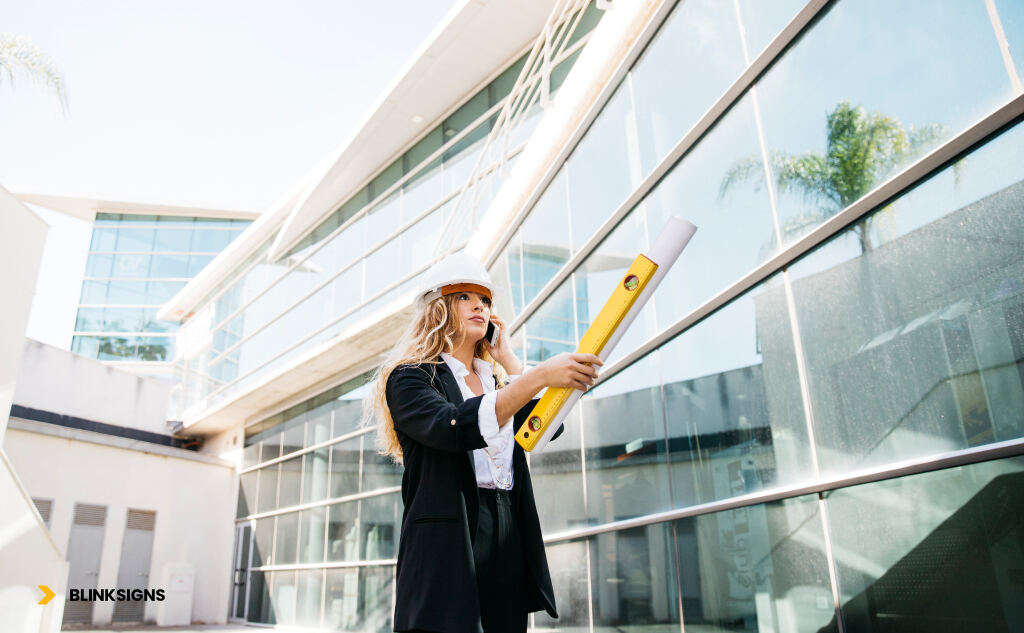
Why Businesses Use Security Films
Intrusion and Burglary Resistance
One of the strongest drivers of security film adoption is burglary deterrence. Smash-and-grab thefts happen fast, often before alarms or police can respond. Security film makes that quick entry nearly impossible. The reinforced surface delays intruders, buys valuable time, and usually forces criminals to abandon their attempt.
Blast and Impact Mitigation
In high-risk environments—such as government facilities, airports, or chemical plants—blast mitigation films are essential. These films comply with ASTM and ANSI standards, ensuring glass fragments don’t become lethal projectiles during an explosion. Even in commercial offices, added impact resistance protects against accidents like furniture collisions or equipment mishandling.
Natural Disaster Protection
Hurricanes, tornadoes, and severe storms pose another challenge. Unprotected glass often shatters under flying debris, exposing interiors to wind and rain. Storm protection films are an affordable retrofit in coastal or storm-prone regions that keep businesses compliant with ICC building codes while safeguarding assets.
Safer Environments for Schools, Offices, and Retail
Schools face increasing pressure to enhance safety and security. Security films provide a discreet, cost-effective way to strengthen vulnerable entry points. Retailers use them to protect merchandise, while corporate offices adopt them to meet insurance requirements and provide employees with a safer workplace.
Technical Standards and Compliance
Choosing the right security film is not only about protection—it’s also about meeting legal and safety standards. Compliance ensures that your building remains insurable, reduces liability, and aligns with public safety regulations.
Security Film Thickness Ratings Explained
Film thickness is measured in mils (1 mil = 0.001 inch). Thinner films like 4mil provide basic shatter resistance, while 8mil and 12mil films are recommended for high-risk environments requiring burglary or blast protection.
| Thickness | Application | Protection Level |
| 4mil | Offices, schools | Basic safety + UV |
| 6–8mil | Retail, corporate | Forced entry + storms |
| 12mil | High-security facilities | Blast + extreme impact |
Building Codes and Safety Standards
Security films are tested against recognized safety benchmarks, including:
- ANSI Z97.1 – Safety glazing standard.
- CPSC 16 CFR 1201 – Federal safety regulation for architectural glazing.
- ASTM standards – Impact resistance and performance testing.
- ICC Building Codes – Regional compliance for commercial and institutional buildings.
When Compliance Is Legally Required
In some sectors, security film is not optional. Healthcare facilities, government buildings, and educational institutions often must meet glazing safety codes to reduce liability. Additionally, LEED-certified projects may require films that balance safety with energy efficiency.
Installation Process (Step-by-Step)
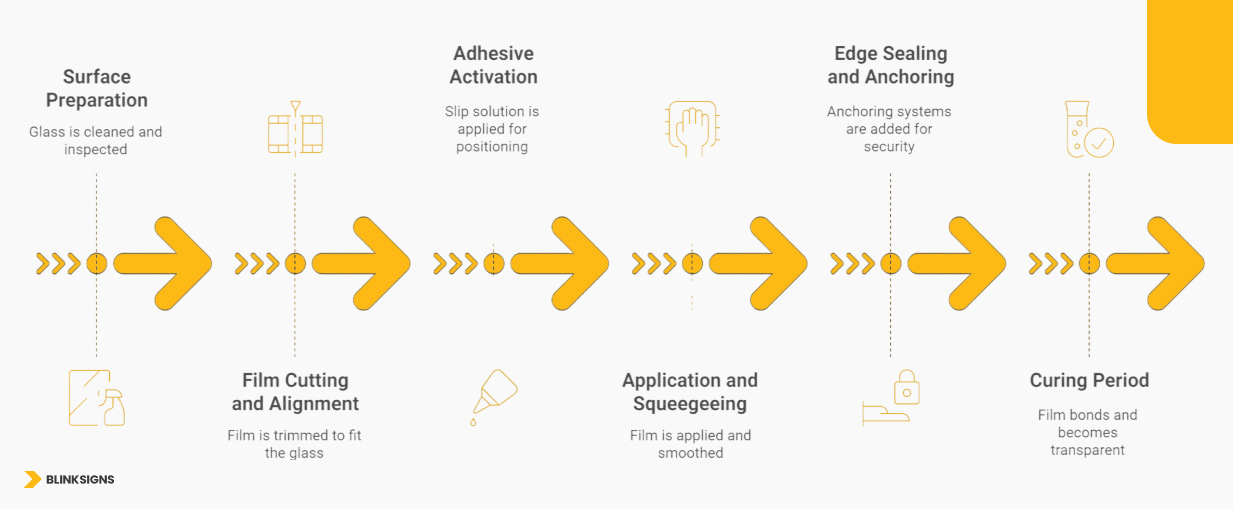
Installation Process of Security films (Step-by-Step)
Installing security window films is a precise process, determining how effective the film will be in real-world conditions. Poor application leads to bubbles, peeling edges, and compromised performance, while a professional installation ensures long-lasting durability.
Professional Installation vs DIY
Some property owners consider applying films themselves, but this approach often results in wasted materials and ineffective coverage. DIY kits may work for small residential windows, but commercial spaces require trained installers who understand edge anchoring systems, compliance standards, and large-surface applications.
Professional installation also comes with warranty coverage, guaranteeing film performance for years. Businesses value peace of mind when they know their investments are properly installed and compliant with safety codes.
Installation Steps: From Preparation to Sealing
A proper installation typically follows these steps:
- Surface Preparation – Glass is thoroughly cleaned and inspected for cracks, scratches, or contaminants.
- Film Cutting and Alignment – The security film is trimmed to fit each pane with precise measurements.
- Adhesive Activation – A slip solution allows proper film positioning before adhesion.
- Application and Squeegeeing – Film is carefully applied and smoothed, and air bubbles are removed.
- Edge Sealing and Anchoring – Mechanical anchoring systems are added to strengthen glass-to-frame adhesion for high-security applications.
- Curing Period – Films require several days to bond and clear, leaving a transparent finish entirely.
Maintenance and Durability Over Time
Once installed, security films require minimal upkeep. Regular cleaning with non-abrasive solutions keeps them clear and functional. Most films last 10 to 15 years, depending on exposure to sunlight and environmental conditions. At BlinkSigns, our clients often choose films with manufacturer-backed warranties, ensuring consistent protection for years without frequent replacement.
Security Film vs Alternatives
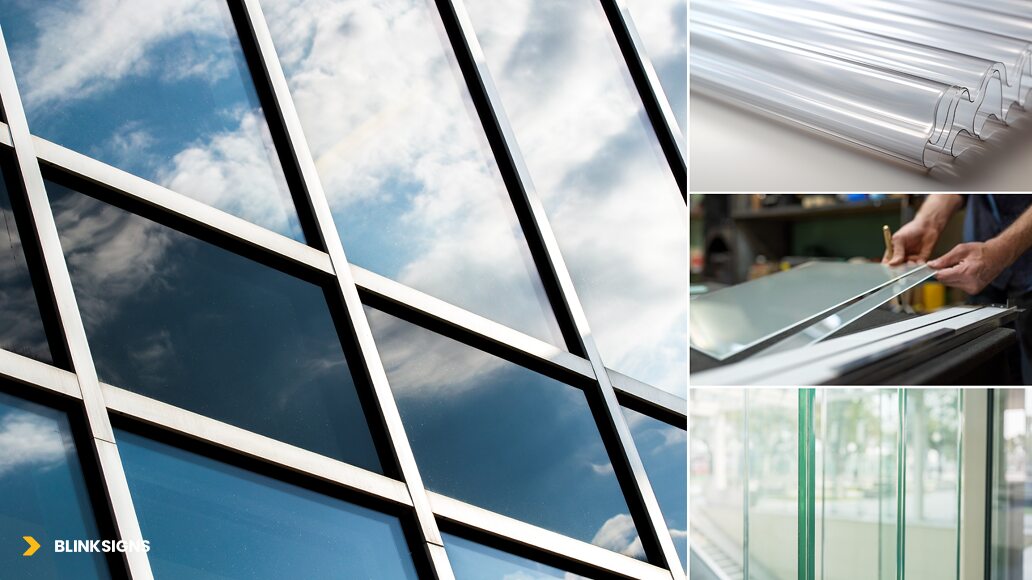
Security Film vs Alternatives
Business owners often compare security films with other glazing solutions to determine the best option for their property. While alternatives like laminated glass or polycarbonate glazing offer protection, security films remain the most cost-effective retrofit.
| Solution | Cost | Protection Level | Best For |
| Security Film (4–12mil) | Low–Medium | Intrusion, impact, UV, storms | Retrofitting existing glass in schools, retail, and offices |
| Laminated Glass | High | Strong intrusion + safety | New construction or complete glass replacement |
| Tempered Glass | Medium | Safer break pattern only | Basic safety compliance, less security |
| Polycarbonate Glazing | Very High | Ballistic + extreme impact | Military, high-security, or critical infrastructure |
| Security Screens | Medium–High | Intrusion deterrence | Residential + storefront add-ons |
For most commercial clients, security film delivers the ideal balance of safety, affordability, and compliance without major renovations.
Industry Use Cases and BlinkSigns Expertise
Retail and Commercial Applications
Storefronts are among the most frequent targets for smash-and-grab crimes. Security films help retailers reduce loss, maintain customer confidence, and often qualify for insurance discounts.
Schools and Public Safety
School administrators face increasing pressure to strengthen safety without altering the welcoming environment of classrooms. Security films for schools provide discreet yet powerful reinforcement for vulnerable entry points, giving parents and staff greater confidence in daily security.
Healthcare and Corporate Facilities
Hospitals, clinics, and office towers often use films that combine privacy, energy efficiency, and impact resistance. BlinkSigns works closely with property managers to balance safety with compliance, especially in facilities governed by CPSC and ANSI glazing standards.
BlinkSigns Security Film Installation Services
At BlinkSigns, we go beyond product installation. Our team provides consultation, compliance assessments, and professional application, ensuring each project aligns with ICC building codes and ASTM standards. Whether upgrading a single office or securing a multi-campus institution, BlinkSigns tailors solutions to the unique needs of every client.
FAQs
How long do security films last?
Most films last 10–15 years, depending on exposure and maintenance. Premium films may carry extended warranties.
What thickness is best for security films?
For commercial use, 8mil is the standard. 12mil films are recommended for high-risk facilities requiring blast or extreme impact protection.
Can security films stop bullets?
Security films significantly slow forced entry and absorb impact, but are not bulletproof. For ballistic resistance, laminated or polycarbonate glazing is required.
Is DIY installation effective?
DIY installation may work for small residential windows, but it is not recommended for commercial properties. Professional installation ensures compliance, performance, and warranty coverage.
How much does professional installation cost?
Pricing depends on film type, thickness, and window size. Security films are generally more affordable than replacing glass with laminated or polycarbonate options.
Conclusion
Unprotected glass exposes businesses to risks they cannot afford—from burglary and vandalism to accidents and natural disasters. Security films offer a cost-effective, compliant, and long-lasting solution that strengthens glass without replacing it.
At BlinkSigns, we combine industry expertise, certified installation, and compliance knowledge to deliver security film solutions that safeguard people, assets, and brand reputation.
👉 Take the first step today. Contact BlinkSigns for a free consultation and learn how our security films can protect your business while saving long-term costs.